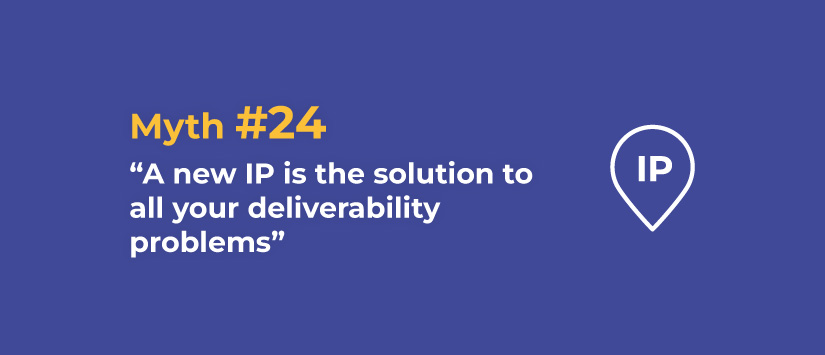Category: Email Marketing

When something doesn't work, the quick way to fix it is to replace it with a new one. But, if my IP (Internet Protocol) ends up blacklisted and all my messages are considered spam, it is a myth that it is possible to fix it by sending from another one. There are other factors involved in deliverability, not just the IP or that it is a dedicated one, so the problem may not be solved and similar data may be maintained despite the change, or even worse!
An IP address is a set of numbers that identifies devices connected to the internet. All domains and their email servers are assigned one, and there are basically two types:
Mail providers create lists of IP addresses and treat these senders differently according to their degree of danger. There are three types of lists:
Changing the IP to a new one does not solve all deliverability problems because deliverability is only one of many elements that make up the sender's reputation. The better it is, the better deliverability for the messages you send, but it is not enough to use a different IP because you can still fall into other bad practices that influence the messages to be considered spam.
Achieving 100% deliverability is a myth, although it is possible to get close if you take care of all the factors. Starting with the IP, reputation takes into account bounces and complaints from recent mailings, not just the most recent one. By using a new one, the history is lost, which may help a bit because past errors can be avoided, but it certainly does not automatically whitelist or suddenly increase deliverability.
The sender's domain may be different from the IP, so authentication protocols are a determining factor. On the one hand, with an SPF (Sender Policy Framework) record, the recipient's incoming mail server validates that the message was sent from an IP authorised by the sender. This helps to prevent spoofing tactics.
On the other hand, the DMARC (Domain-based Message Authentication, Reporting, & Conformance) protocol focuses on the domain to confirm that it is authenticated and not fraudulent. By setting up this record, the sender ensures that only the sender can send messages from that email address.
But there are other factors that affect deliverability that are not directly related to the IP, such as the content of the messages that may include some words considered typical of spammers, the behaviour of users when opening or clicking on the communications or the layout of the campaign that should avoid strange codes or attachments.
When you get a new IP, there is no sending history and deliverability may drop because ISPs do not yet know how to classify it. This is why it is good practice to warm it up before continuing with the usual frequency and volume to gradually build its reputation. You could say that it is like training before a marathon: you have to prepare your body with some exercises if you want to reach the finish line.
Warming up an IP consists of sending to a part of the list and progressively increasing the percentage, for example 15% daily, until you reach the total. It is recommended that campaigns are segmented so that the first groups are made up of the most active users. In this way, there will be more possibilities for them to interact, the email servers will not consider the sender as a spammer and a good reputation will be built up.
The process of warming up a new IP can take several weeks, at least a month, although it will depend on the total volume you want to reach and also on the interactions of the recipients. This is why it is important to keep an eye on the number of inactive users because they can affect the success of the process if they are more than 25%. In addition, it is advisable to verify the email addresses on the list before making the first send from the new IP to make sure that it does not include spamtraps.
Warming up an IP can only be done with a dedicated one, but the advantage is clear for deliverability: you do not risk your reputation all at once with a first sending of thousands of messages, but build it day by day to get the new IP to have a good reputation and to increase the percentage of the mails that go directly to the inbox.
Do not miss anything from our blog and join our Telegram https://t.me/acrelianews
Haven't you tried Acrelia News yet?
If you like this post, you will like much more our email marketing tool: professional, easy to use.